

实践GoF的23种设计模式实现:桥接模式
描述
简介
GoF 对桥接模式(Bridge Pattern)的定义如下:
Decouple an abstraction from its implementation so that the two can vary independently.
也即,将抽象部分和实现部分进行解耦,使得它们能够各自往独立的方向变化。
桥接模式解决了在模块有多种变化方向的情况下,用继承所导致的类爆炸问题。
举个例子,一个产品有形状和颜色两个特征(变化方向),其中形状分为方形和圆形,颜色分为红色和蓝色。如果采用继承的设计方案,那么就需要新增4个产品子类:方形红色、圆形红色、方形蓝色、圆形红色。如果形状总共有 m 种变化,颜色有 n 种变化,那么就需要新增 m * n 个产品子类!
现在我们使用桥接模式进行优化,将形状和颜色分别设计为抽象接口独立出来,这样需要新增 2 个形状子类:方形和圆形,以及 2 个颜色子类:红色和蓝色。同样,如果形状总共有 m 种变化,颜色有 n 种变化,总共只需要新增 m + n 个子类!
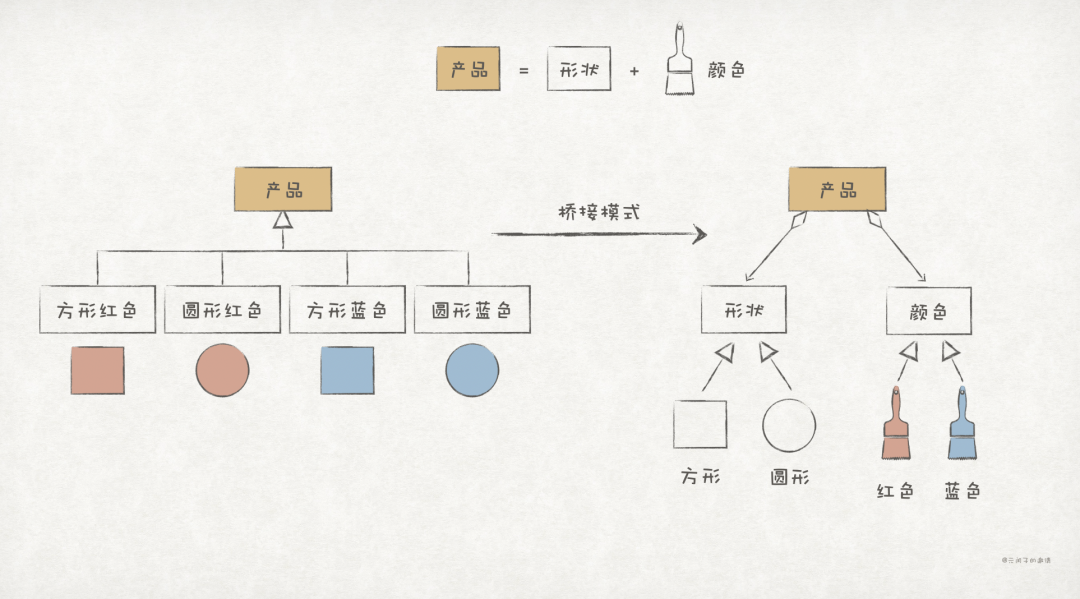
上述例子中,我们通过将形状和颜色抽象为一个接口,使产品不再依赖于具体的形状和颜色细节,从而达到了解耦的目的。桥接模式本质上就是面向接口编程,可以给系统带来很好的灵活性和可扩展性。如果一个对象存在多个变化的方向,而且每个变化方向都需要扩展,那么使用桥接模式进行设计那是再合适不过了。
当然,Go 语言从语言特性本身就把继承剔除,但桥接模式中分离变化、面向接口编程的思想仍然值得学习。
UML 结构
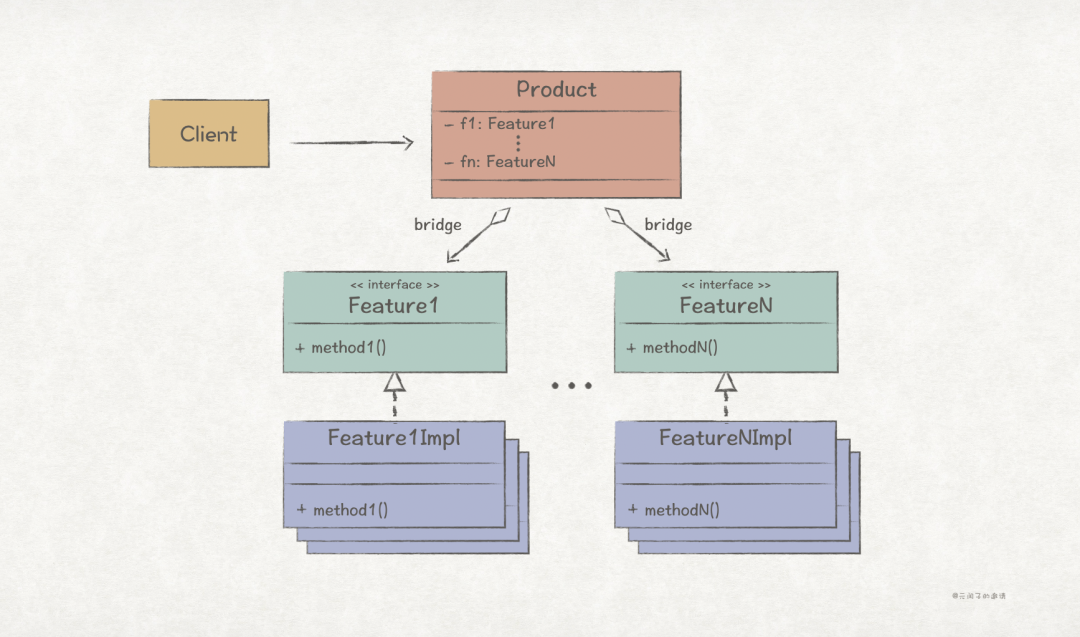
场景上下文
在 简单的分布式应用系统(示例代码工程)中,我们设计了一个 Monitor 监控系统模块,它可以看成是一个简单的 ETL 系统,负责对监控数据进行采集、处理、输出。监控数据来源于在线商场服务集群各个服务,当前通过消息队列模块 Mq 传递到监控系统,经处理后,存储到数据库模块 Db 上。
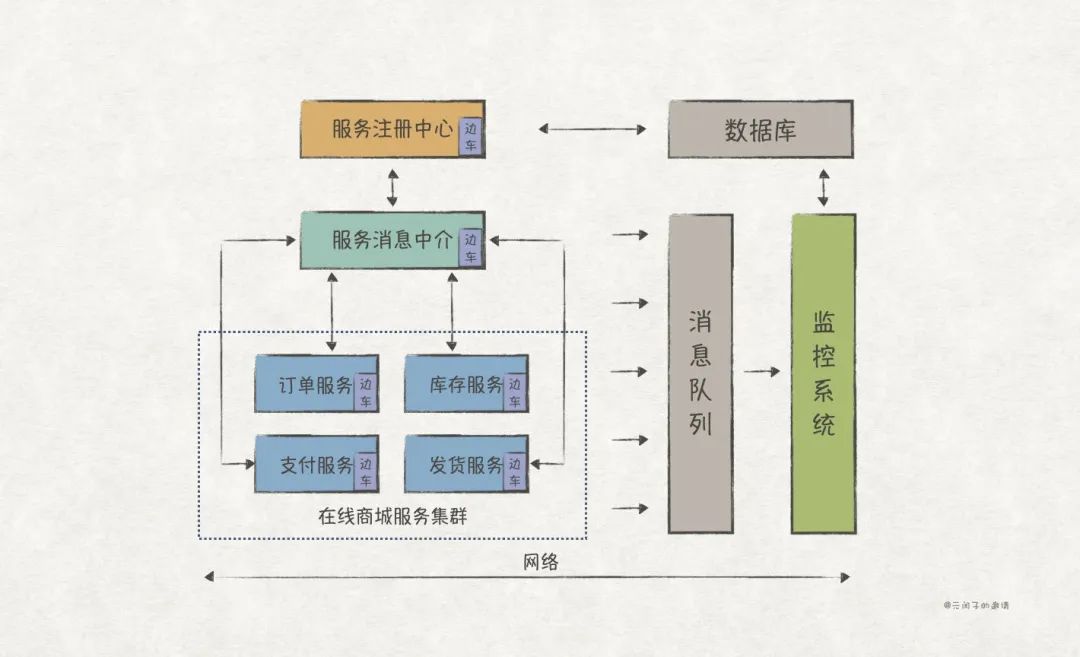
我们假设未来要上线一个不支持对接消息队列的服务、结果数据也需要存储到 ClickHouse 以供后续分析,为了应对未来多变的需求,我们有必要将监控系统设计得足够的可扩展。
于是,整个模块被设计为插件化风格的架构,Pipeline 是数据处理的流水线,其中包含了 Input、Filter 和 Output 三类插件,Input 负责从各类数据源中获取监控数据,Filter 负责数据处理,Output 负责将处理后的数据输出。
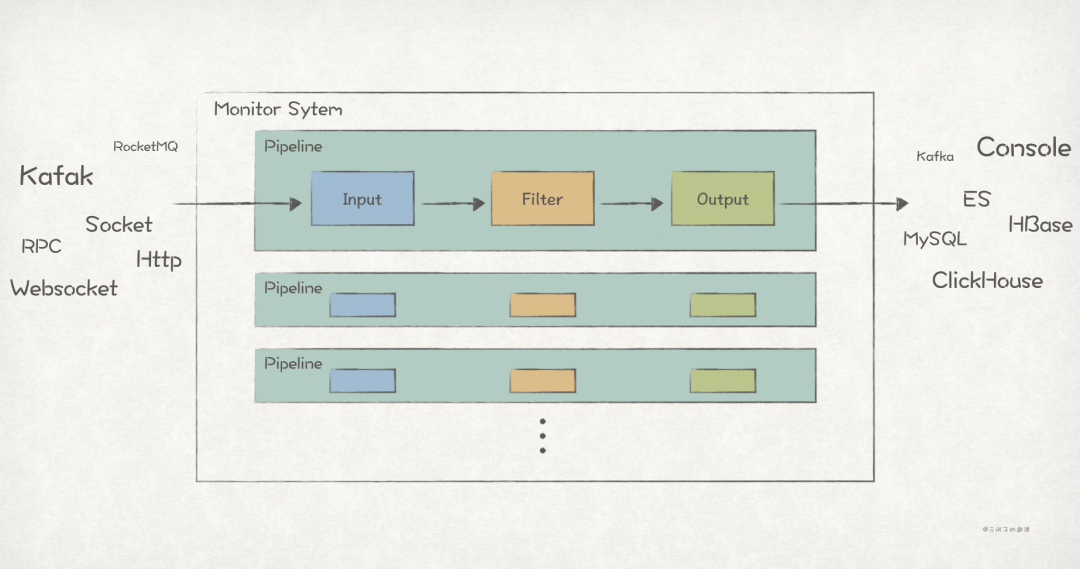
上述设计中,我们抽象出 Input、Filter 和 Output 三类插件,它们各种往独立的方向变化,最后在 Pipeline 上进行灵活组合,这使用桥接模式正合适。
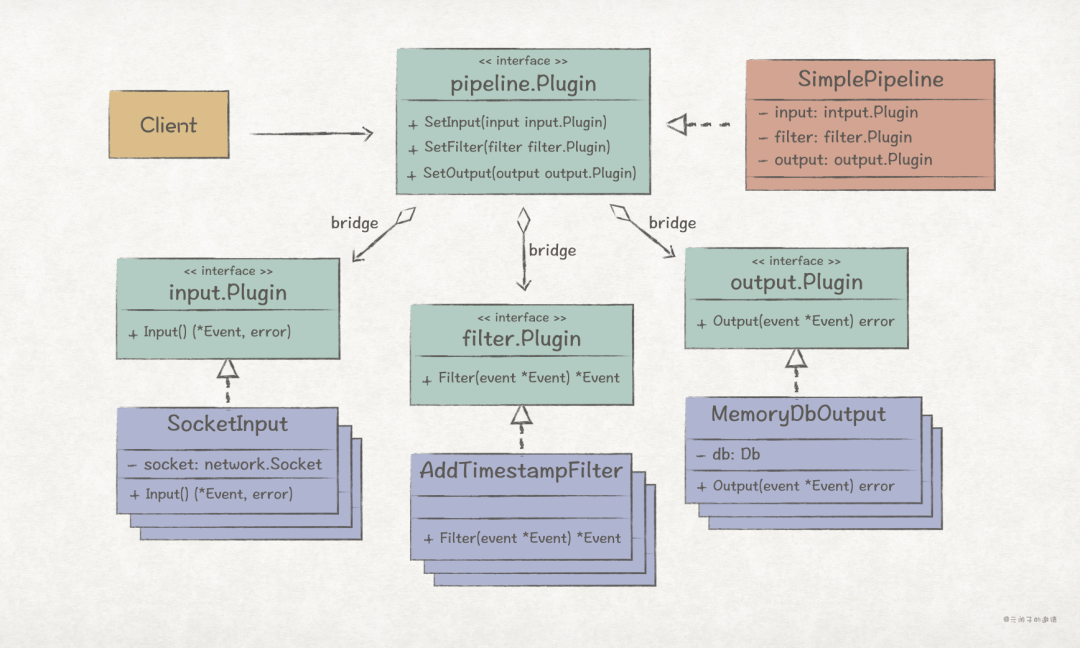
代码实现
// 关键点1:明确产品的变化点,这里是input、filter和output三类插件,它们各自变化
// demo/monitor/input/input_plugin.go
package input
// 关键点2:将产品的变化点抽象成接口,这里是input.Plugin,filter.Plugin和output.Plugin
// Plugin 输入插件
type Plugin interface {
plugin.Plugin
Input() (*plugin.Event, error)
}
// 关键点3:实现产品变化点的接口,这里是SocketInput, AddTimestampFilter和MemoryDbOutput
// demo/monitor/input/socket_input.go
type SocketInput struct {
socket network.Socket
endpoint network.Endpoint
packets chan *network.Packet
isUninstall uint32
}
func (s *SocketInput) Input() (*plugin.Event, error) {
packet, ok := <-s.packets
if !ok {
return nil, plugin.ErrPluginUninstalled
}
event := plugin.NewEvent(packet.Payload())
event.AddHeader("peer", packet.Src().String())
return event, nil
}
// demo/monitor/filter/filter_plugin.go
package filter
// Plugin 过滤插件
type Plugin interface {
plugin.Plugin
Filter(event *plugin.Event) *plugin.Event
}
// demo/monitor/filter/add_timestamp_filter.go
// AddTimestampFilter 为MonitorRecord增加时间戳
type AddTimestampFilter struct {
}
func (a *AddTimestampFilter) Filter(event *plugin.Event) *plugin.Event {
re, ok := event.Payload().(*model.MonitorRecord)
if !ok {
return event
}
re.Timestamp = time.Now().Unix()
return plugin.NewEvent(re)
}
// demo/monitor/output/output_plugin.go
// Plugin 输出插件
type Plugin interface {
plugin.Plugin
Output(event *plugin.Event) error
}
// demo/monitor/output/memory_db_output.go
type MemoryDbOutput struct {
db db.Db
tableName string
}
func (m *MemoryDbOutput) Output(event *plugin.Event) error {
r, ok := event.Payload().(*model.MonitorRecord)
if !ok {
return fmt.Errorf("memory db output unknown event type %T", event.Payload())
}
return m.db.Insert(m.tableName, r.Id, r)
}
// 关键点4:定义产品的接口或者实现,通过组合的方式把变化点桥接起来。
// demo/monitor/pipeline/pipeline_plugin.go
// Plugin pipeline由input、filter、output三种插件组成,定义了一个数据处理流程
// 数据流向为 input -> filter -> output
// 如果是接口,可以通过定义Setter方法达到聚合的目的。
type Plugin interface {
plugin.Plugin
SetInput(input input.Plugin)
SetFilter(filter filter.Plugin)
SetOutput(output output.Plugin)
}
// 如果是结构体,直接把变化点作为成员变量来达到聚合的目的。
type pipelineTemplate struct {
input input.Plugin
filter filter.Plugin
output output.Plugin
isClose uint32
run func()
}
func (p *pipelineTemplate) SetInput(input input.Plugin) {
p.input = input
}
func (p *pipelineTemplate) SetFilter(filter filter.Plugin) {
p.filter = filter
}
func (p *pipelineTemplate) SetOutput(output output.Plugin) {
p.output = output
}
// demo/monitor/pipeline/simple_pipeline.go
// SimplePipeline 简单Pipeline实现,每次运行时新启一个goroutine
type SimplePipeline struct {
pipelineTemplate
}
在本系统中,我们通过配置文件来灵活组合插件,利用反射来实现插件的实例化,实例化的实现使用了抽象工厂模式,详细的实现方法可参考【Go实现】实践GoF的23种设计模式:抽象工厂模式。
总结实现桥接模式的几个关键点:
明确产品的变化点,这里是 input、filter 和 output 三类插件,它们各自变化。
将产品的变化点抽象成接口,这里是 input.Plugin,filter.Plugin 和 output.Plugin。
实现产品变化点的接口,这里是 SocketInput, AddTimestampFilter 和 MemoryDbOutput。
定义产品的接口或者实现,通过组合的方式把变化点桥接起来。这里是 pipeline.Plugin 通过 Setter方法将input.Plugin,filter.Plugin 和 output.Plugin 三个抽象接口桥接了起来。后面即可实现各类 input、filter 和 output 的灵活组合了。
扩展
TiDB 中的桥接模式
TiDB 是一款出色的分布式关系型数据库,它对外提供了一套插件框架,方便用户进行功能扩展。TiDB 的插件框架的设计,也运用到了桥接模式的思想。
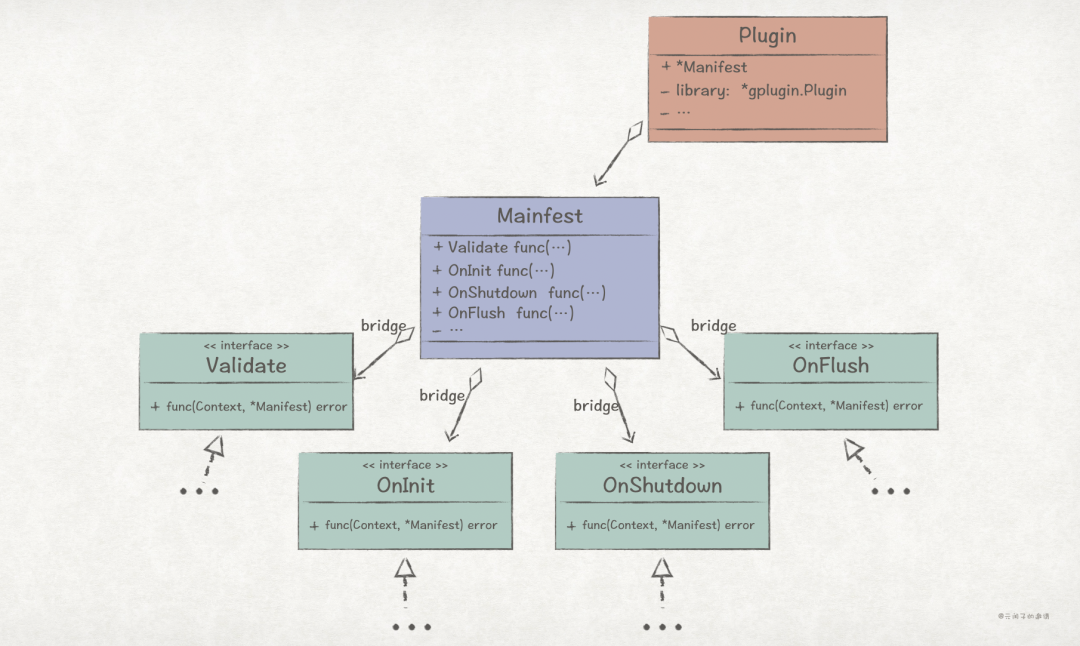
如上图所示,每个 Plugin 都包含 Validate、OnInit、OnShutdown、OnFlush 四个待用户实现的接口,它们可以按照各自的方向去变化,然后灵活组合在 Plugin 中。
// Plugin presents a TiDB plugin.
type Plugin struct {
*Manifest
library *gplugin.Plugin
Path string
Disabled uint32
State State
}
// Manifest describes plugin info and how it can do by plugin itself.
type Manifest struct {
Name string
Description string
RequireVersion map[string]uint16
License string
BuildTime string
// Validate defines the validate logic for plugin.
// returns error will stop load plugin process and TiDB startup.
Validate func(ctx context.Context, manifest *Manifest) error
// OnInit defines the plugin init logic.
// it will be called after domain init.
// return error will stop load plugin process and TiDB startup.
OnInit func(ctx context.Context, manifest *Manifest) error
// OnShutDown defines the plugin cleanup logic.
// return error will write log and continue shutdown.
OnShutdown func(ctx context.Context, manifest *Manifest) error
// OnFlush defines flush logic after executed `flush tidb plugins`.
// it will be called after OnInit.
// return error will write log and continue watch following flush.
OnFlush func(ctx context.Context, manifest *Manifest) error
flushWatcher *flushWatcher
Version uint16
Kind Kind
}
TiDB 在实现插件框架时,使用函数式编程的方式来定义 OnXXX 接口,更具有 Go 风格。
典型应用场景
从多个维度上对系统/类/结构体进行扩展,如插件化架构。
在运行时切换不同的实现,如插件化架构。
用于构建与平台无关的程序适配层。
优缺点
优点
可实现抽象不分与实现解耦,变化实现时,客户端无须修改代码,符合开闭原则。
每个分离的变化点都可以专注于自身的演进,符合单一职责原则。
缺点
过度的抽象(过度设计)会使得接口膨胀,导致系统复杂性变大,难以维护。
与其他模式的关联
桥接模式通常与抽象工厂模式搭配使用,比如,在本文例子中,可以通过抽象工厂模式对各个 Plugin 完成实例化,详情见【Go实现】实践GoF的23种设计模式:抽象工厂模式。
文章配图
可以在 用Keynote画出手绘风格的配图 中找到文章的绘图方法。
审核编辑:刘清
-
关于桥接模式遇到的问题2014-10-16 3576
-
CentOS静态IP配置(桥接模式)2020-05-12 1181
-
23种基本的设计模式总结2022-03-01 886
-
C#23种设计模式【完整】2017-08-21 1837
-
23种java设计模式2022-09-23 485
-
实践GoF的23种设计模式:命令模式简介2023-01-13 1559
-
桥接模式的目标与设计2023-06-01 967
-
设计模式结构性:桥接模式2023-06-08 1431
-
远程网关桥接模式实现同一局域网组网管理(Superlink)2023-04-26 2596
-
桥接模式应用场景2023-10-09 1933
-
实践GoF的23种设计模式:备忘录模式2023-11-25 1139
-
实践GoF的23种设计模式:适配器模式2023-12-10 1141
-
VMware虚拟机的三种网络模式2024-02-04 3138
-
实践GoF的23种设计模式:解释器模式2024-04-01 1316
-
网络桥接模式是什么? 网络桥接模式和路由模式的区别2024-05-10 7956
全部0条评论

快来发表一下你的评论吧 !

